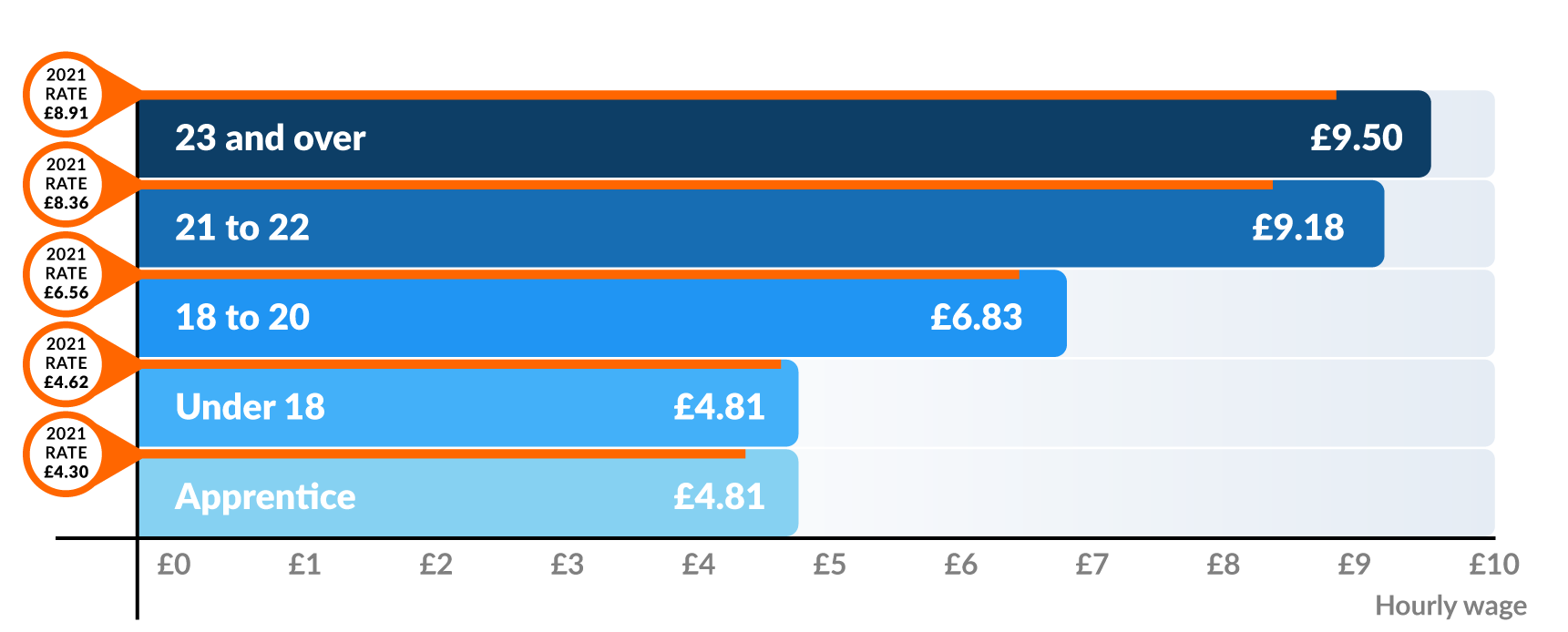- Get a quote
- Jobs
-
Employers
- Employers
-
Hire Staff
-
Our Sectors
-
Testimonials
-
About
- About
-
Our Team
-
Our Company
- Contact
- Blog
- EN | PL
2022 Minimum Wage Increase

Posted by
HR GO Recruitment
on
Increases in both the 2022 National Minimum Wage (NMW) and National Living Wage (NLW) take place on April 1st (although when it kicks in for your pay may be later in the month) . Here's a short explanation of how these changes affect both employers and employees. We start with a comparison between NMW and NLW.
The National Minimum Wage vs National Living Wage
Here's a quick summary of the differences between NMW, NLW and when apprentice rates are allowed:
All UK workers under age 23 are entitled to the National Minimum Wage if they are:
- Non-apprentices who are at least school leaving age, or
- Apprentices who are at least 19 years old AND have completed their first year of apprenticeship
All UK workers are entitled to the National Living Wage if they are:
- Non-apprentices who are aged 23 or older, or
- Apprentices aged 23 or older who have completed their first year of apprenticeship
To clarify the apprenticeship qualifications: apprentices receive the apprentice rate only if they are:
- Aged under 19, or
- Aged 19 or over and in their first year of apprenticeship
What if an employer doesn't pay the minimum rate?
Employers that don't pay at least the minimum rate must pay back what's owed to their employees and suffer a hefty government fine. This could be up to 200% of what's owed to their employees up to £20,000 per employee. They could also be featured in the annual list of shame.
So, it's essential that employers make sure they have accurately calculated and adjusted for this change before it takes effect. This includes making sure all work-related activities are included that count as working time. That means everything from employee training at work and traveling between appointments to shift overruns and working lunches.
How are minimum wages calculated?
Minimum wages are set as hourly rates but apply to workers even if they're not paid by the hour. If, as an employer, you pay annually, monthly or for piece work, you will need to work out the equivalent hourly rate to see if you’re meeting legal minimums. Workers can do the same to check they are receiving at least the minimum. Here's how to calculate hourly wage from an annual salary:
(Annual salary ÷ 52) ÷ hours worked per week = hourly rate
EXAMPLE: Supposing the annual salary you're paying or being paid is the UK average salary for 2022: £24,600 and work hours for that salary are 37.5 hours per week. Here’s how you would calculate the hourly wage:
- Divide annual salary by 52: £24,600 ÷ 52 = £473 (this is the weekly wage)
- Take the weekly wage and divide by number of hours worked per week: £473 ÷ 37.5 = £12.61 (this is the hourly wage)
Workers can also check they are being paid the NMW and NLW, or if their employer owes them from a previous year, by using the government's online calculator.
2022 Minimum Wage increases
The table below shows the increases for all age ranges for 2022. You can also find the details on the government's Minimum Wage Rates for 2022 compiled by the Low Pay Commission.

Percentage increases over last year
- National Living wage (23 years and over): 6.6%
- 21 - 22 year olds: 9.8%
- 18 - 20 year olds: 4.1%
- 16 - 17 year olds: 4.1%
- Apprentices in their first year: 11.9%
- Accommodation offset: 4.1%
Getting help with Minimum Wage increase issues
ACAS provides a helpline available Monday - Friday from 8 am to 6 pm for anyone needing help with minimum wage issues as an employer or employee.
Categories
Featured insights
Are remote female workers facing a new gender divide?
When it comes to equality in the workplace, there's a new gender divide contributor to look out for: remote working.
Read moreRecent insights
Universal Credit Changes: Get the right job fast
Universal Credit changes got you worried about finding a job in 4 weeks? Here are our top tips on how to find the right job for you, fast.
Read moreHow to solve the challenges of working from home
Now so many of us are remote working, we've also discovered the challenges of working from home. Here are some tips for simple solutions.
Read more